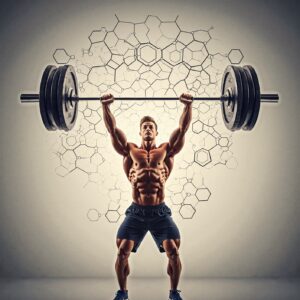Testosterone is a vital hormone that plays a central role in men’s health. It influences a wide range of physiological and psychological functions, including energy levels, muscle mass, bone density, mood, and sexual function. Understanding the role of testosterone, recognizing the symptoms of low testosterone (Low-T), and exploring treatment options like testosterone replacement therapy (TRT) are essential for maintaining overall well-being.
The Role of Testosterone in Men’s Health
Testosterone is the primary male sex hormone, produced mainly in the testes, with small amounts also produced by the adrenal glands. It is responsible for the development of male reproductive tissues, such as the testes and prostate, and secondary sexual characteristics, including increased muscle and bone mass, body hair, and a deeper voice. Beyond these physical traits, testosterone also plays a critical role in:
- Energy Levels: Testosterone helps regulate energy production and overall vitality. Low levels can lead to fatigue and reduced stamina.
- Muscle Mass and Strength: It promotes protein synthesis, which is essential for building and maintaining muscle mass.
- Bone Density: Testosterone supports bone health by stimulating bone mineralization, reducing the risk of osteoporosis.
- Mood and Cognitive Function: Adequate testosterone levels are linked to improved mood, focus, and mental clarity.
- Sexual Function: Testosterone is crucial for libido (sex drive), erectile function, and sperm production.
Testosterone levels naturally peak during adolescence and early adulthood, then gradually decline with age, typically by about 1% per year after the age of 30. However, some men experience a more significant drop, leading to a condition known as low testosterone or Low-T.
Symptoms of Low Testosterone (Low-T)
Low testosterone can manifest in various ways, affecting both physical and emotional health. Common symptoms include:
- Fatigue: Persistent tiredness and lack of energy, even after adequate rest.
- Reduced Muscle Mass and Strength: Difficulty building or maintaining muscle, along with increased body fat.
- Decreased Libido and Sexual Dysfunction: Lowered sex drive, difficulty achieving or maintaining erections, and reduced sperm production.
- Mood Changes: Depression, irritability, anxiety, and difficulty concentrating.
- Sleep Disturbances: Insomnia or disrupted sleep patterns.
- Decreased Bone Density: Increased risk of fractures and osteoporosis.
- Hair Loss: Thinning or loss of body and facial hair.
These symptoms can significantly impact quality of life, but they are not always specific to Low-T. Other medical conditions, such as thyroid disorders, depression, or chronic illnesses, can produce similar symptoms. Therefore, a proper diagnosis is essential.
Diagnosing Low Testosterone
Low testosterone is diagnosed through a combination of symptom assessment and blood tests. A healthcare provider will typically measure total testosterone levels in the morning when levels are highest. Normal testosterone levels range from approximately 300 to 1,000 ng/dL, but the exact threshold for Low-T can vary depending on the laboratory and individual factors. If levels are consistently below the normal range and symptoms are present, a diagnosis of Low-T may be made.
Testosterone Replacement Therapy (TRT)
Testosterone replacement therapy (TRT) is a common treatment for men with Low-T. It involves supplementing testosterone to restore levels to the normal range. TRT can be administered in several forms, including:
- Injections: Intramuscular injections are typically given every 1-2 weeks.
- Gels or Creams: Applied daily to the skin, allowing testosterone to be absorbed through the bloodstream.
- Patches: Worn on the skin and replaced daily.
- Pellets: Implanted under the skin, releasing testosterone over several months.
- Oral Tablets: Less commonly used due to potential liver side effects.
Benefits of TRT
TRT can provide significant benefits for men with Low-T, including:
- Improved Energy Levels: Many men report feeling more energetic and less fatigued.
- Increased Muscle Mass and Strength: TRT can help rebuild muscle and reduce body fat.
- Enhanced Sexual Function: Improved libido, erectile function, and overall sexual satisfaction.
- Better Mood and Mental Clarity: Reduced symptoms of depression and anxiety, along with improved focus and memory.
- Stronger Bones: Increased bone density, reducing the risk of fractures.
Risks and Considerations of TRT
While TRT can be highly effective, it is not without risks. Potential side effects include:
- Cardiovascular Risks: Some studies suggest a possible link between TRT and an increased risk of heart attack or stroke, though the evidence is mixed.
- Prostate Health: TRT may stimulate the growth of prostate tissue, potentially worsening benign prostatic hyperplasia (BPH) or increasing the risk of prostate cancer.
- Sleep Apnea: TRT can exacerbate sleep apnea in some men.
- Fertility Issues: TRT can suppress natural testosterone production and sperm production, potentially leading to infertility.
- Skin Reactions: Gels, creams, or patches may cause skin irritation.
It is crucial to undergo TRT under the supervision of a qualified healthcare provider, who can monitor testosterone levels and adjust treatment as needed.
Lifestyle and Natural Ways to Support Testosterone Levels
In addition to TRT, lifestyle changes can help optimize testosterone levels and overall health. These include:
- Regular Exercise: Strength training and high-intensity interval training (HIIT) are particularly effective for boosting testosterone.
- Healthy Diet: A balanced diet rich in protein, healthy fats, and micronutrients like zinc and vitamin D supports testosterone production.
- Adequate Sleep: Poor sleep can lower testosterone levels, so aim for 7-9 hours of quality sleep per night.
- Stress Management: Chronic stress increases cortisol, which can suppress testosterone production.
- Weight Management: Maintaining a healthy weight reduces the risk of Low-T, as excess body fat can convert testosterone into estrogen.
Conclusion
Testosterone is a cornerstone of men’s health, influencing energy, muscle mass, sexual function, and overall well-being. Recognizing the symptoms of Low-T and seeking appropriate treatment, such as testosterone replacement therapy, can significantly improve quality of life. However, TRT is not without risks, and lifestyle changes should also be prioritized to support natural testosterone production. By taking a proactive approach to testosterone health, men can maintain vitality and improve their overall health as they age.
